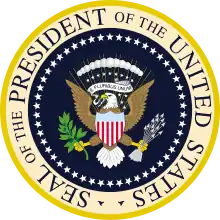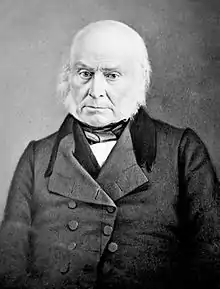American politician John Quincy Adams served as President of the United States (1825–1829) and United States Secretary of State (1817–1825). Prior to being president, he had served as United States Senator from Massachusetts (1803–1808) and had diplomatic experience as United States Minister to United Kingdom (1815–1817), Russia (1809–1814), Prussia (1797–1801) and the Netherlands (1794–1797). After losing the 1828 presidential election, he served as a member of the U.S. House of Representatives from Massachusetts for 17 years. He is the only American president to be elected to the House of Representatives after leaving office.[1][2]
Early political career
| ||
|---|---|---|
|
6th President of the United States
Presidential campaigns
Post-presidency
|
||
John Quincy Adams was appointed as United States Minister to the Netherlands and ambassador to the Netherlands by George Washington.[3][4] He was also appointed as ambassador to Prussia by his father, John Adams.[5] He was elected to the Massachusetts Senate in 1802. He ran for election for the United States House of Representatives from the Suffolk district, but narrowly lost the election. Soon, he resigned from the Massachusetts Senate on his election to the United States Senate from Massachusetts.
United States Senate elections
1803
| Party | Candidate | Votes | % | |
|---|---|---|---|---|
| Democratic-Republican | Thompson J. Skinner | 71 | 42.0% | |
| Federalist | Timothy Pickering | 67 | 39.6% | |
| Federalist | Nicholas Tillinghast | 12 | 7.1% | |
| Federalist | John Quincy Adams | 12 | 7.1% | |
| Federalist | Henry Knox | 7 | 4.1% | |
| Federalist | Samuel Dexter | 1 | 0.6% | |
| Federalist | William Ely | 1 | 0.6% | |
| Total votes | 169 | 100 | ||
| Party | Candidate | Votes | % | |
|---|---|---|---|---|
| Federalist | Timothy Pickering | 79 | 46.5% | |
| Democratic-Republican | Thompson J. Skinner | 71 | 41.8% | |
| Federalist | Nicholas Tillinghast | 9 | 5.3% | |
| Federalist | John Quincy Adams | 6 | 3.5% | |
| Federalist | Henry Knox | 5 | 2.9% | |
| Total votes | 170 | 100 | ||
| Party | Candidate | Votes | % | |
|---|---|---|---|---|
| Democratic-Republican | Thompson J. Skinner | 71 | 41.5% | |
| Federalist | John Quincy Adams | 56 | 32.8% | |
| Federalist | Timothy Pickering | 33 | 19.3% | |
| Federalist | Nicholas Tillinghast | 10 | 5.9% | |
| Federalist | Henry Knox | 1 | 0.6% | |
| Total votes | 171 | 100 | ||
| Party | Candidate | Votes | % | |
|---|---|---|---|---|
| Federalist | John Quincy Adams | 86 | 50.3% | |
| Democratic-Republican | Thompson J. Skinner | 70 | 40.9% | |
| Federalist | Nicholas Tillinghast | 9 | 5.3% | |
| Federalist | Timothy Pickering | 6 | 3.5% | |
| Total votes | 171 | 100 | ||
| Party | Candidate | Votes | % | |
|---|---|---|---|---|
| Federalist | John Quincy Adams | 19 | 100 | |
| Total votes | 19 | 100 | ||
1808
| Party | Candidate | Votes | % | |
|---|---|---|---|---|
| Federalist | James Lloyd Jr. | 248 | 53.7% | |
| Federalist | John Quincy Adams | 213 | 46.1% | |
| Federalist | Laban Wheaton | 1 | 0.2% | |
| Total votes | 462 | 100 | ||
1841
| Party | Candidate | Votes | % | |
|---|---|---|---|---|
| Whig | Isaac C. Bates | 280 | 69.1% | |
| Democratic | Marcus Morton | 119 | 29.4% | |
| Whig | John Quincy Adams | 3 | 0.7% | |
| Whig | George N. Briggs | 1 | 0.3% | |
| Whig | Levi Lincoln Jr. | 1 | 0.3% | |
| Whig | Franklin Dexter | 1 | 0.3% | |
| Total votes | 405 | 100 | ||
Subsequent positions (1808–1824)
After losing the senate election in 1808, he was appointed United States Minister to Russia, serving from 1809 to 1814, and then United States Minister to United Kingdom, serving from 1815 to 1817, by James Madison. He duly reported on Napoleon's failed invasion, and among various other events. He headed the Commission that negotiated the Treaty of Ghent in 1814, which ended the War of 1812 with Great Britain.[9] He then served as Secretary of State under James Monroe from 1817 to 1825. As Secretary of State, his views about territorial expansion guided President Monroe's policies. His diplomacy with Spain led to the Adams–Onís Treaty of 1819. Monroe Doctrine reflected various of Adams's political views.[10]
Presidential elections
1824
Immediately upon becoming Secretary of State, Adams emerged as one of Monroe's most likely successors for presidency. Since the Federalist Party had collapsed, all the major contenders for presidency were from Democratic-Republican party. His initial choice for vice presidential candidate was Andrew Jackson, but as the election approached, Jackson entered the race for president.[11] Adams was nominated by Massachusetts legislature as presidential candidate.
Popular vote and electoral vote
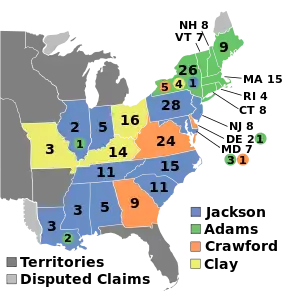
The election of 1824 was the only election in American history in which no presidential candidate received a majority of the votes in the electoral college. Andrew Jackson received 99 electoral votes but was 32 votes short of the amount needed to reach a majority. He won the largest number of popular votes. William H. Crawford received 41 electoral votes, and Henry Clay received 37.
| Presidential candidate | Party | Home state | Popular vote[lower-alpha 1] | Electoral vote | |
|---|---|---|---|---|---|
| Count | Percentage | ||||
| Andrew Jackson[lower-alpha 2] | Democratic-Republican | Tennessee | 151,271 | 41.4% | 99 |
| John Quincy Adams[lower-alpha 3] | Democratic-Republican | Massachusetts | 113,122 | 30.9% | 84 |
| William Harris Crawford[lower-alpha 4] | Democratic-Republican | Georgia | 40,856 | 11.2% | 41 |
| Henry Clay[lower-alpha 5] | Democratic-Republican | Kentucky | 47,531 | 13.0% | 37 |
| Unpledged electors | None | Massachusetts | 6,616 | 1.8% | 0 |
| Other | 6,437 | 1.7% | 0 | ||
| Total | 365,833 | 100.0% | 261 | ||
| Needed to win | 131 | ||||
Contingent election
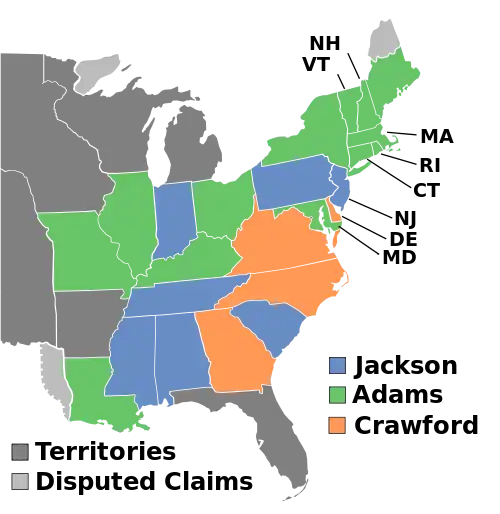
Since no candidate received a clear majority votes in electoral college, the responsibility for electing a new president devolved upon the U.S. House of Representatives, which held a contingent election on February 9, 1825. As prescribed in the 12th Amendment, the top three candidates in electoral college vote would be eligible to receive state delegation votes, and the remaining candidates would be eliminated, accordingly, Henry Clay was eliminated.[13] Henry Clay, the Speaker of the House was highly influential. By contrast, Clay viewed Jackson as a dangerous demagogue, and he was unwilling to support Crawford due to the latter's health issues. Adams and Clay met before the contingent election, and Clay agreed to support Adams in the election.[14] Thus, Adams was elected president on the first ballot.[15]
| 1825 contingent presidential election vote distribution | ||
|---|---|---|
| States for Adams | States for Jackson | States for Crawford |
|
|
|
| Total: 13 (54%) | Total: 7 (29%) | Total: 4 (17%) |
1828
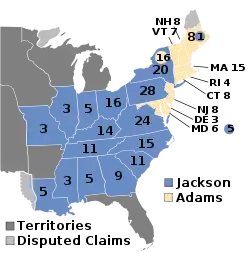
The 1828 presidential election was a rematch between incumbent president Adams and Andrew Jackson. Adams had selected Richard Rush as his vice presidential running mate in the Anti-Jacksonian Party ticket. Andrew Jackson was nominated by Jacksonian Party ticket with John C. Calhoun as his running mate.[16] Adams lost to Jackson in a landslide, and was able to win only those states which his father John Adams had won in the 1800 presidential election. Adams did not attend Jackson's inauguration, making him one of only four presidents who finished their terms but chose to skip the event.[17]
| Presidential candidate | Party | Home state | Popular vote(a) | Electoral vote |
Running mate | |||
|---|---|---|---|---|---|---|---|---|
| Count | Percentage | Vice-presidential candidate | Home state | Electoral vote | ||||
| Andrew Jackson | Democratic | Tennessee | 638,348 | 55.3% | 178 | John Caldwell Calhoun (incumbent) | South Carolina | 171 |
| William Smith | South Carolina | 7 | ||||||
| John Quincy Adams (incumbent) | National Republican | Massachusetts | 507,440 | 44.0% | 83 | Richard Rush | Pennsylvania | 83 |
| Other | 7,991(b) | 0.7% | — | Other | — | |||
| Total | 1,153,779 | 100% | 261 | 261 | ||||
| Needed to win | 131 | 131 | ||||||
House of Representatives elections
Adams contested his first election for House of Representatives in 1802, in which he narrowly lost to William Eustis. After his presidency, he contested the election for House of Representatives from Massachusetts's 11th congressional district. He won the election in a landslide, and wrote in his diary that "my election as President of the United States was not half so gratifying to my inmost soul. No election or appointment conferred upon me ever gave me so much pleasure."[18] He was sworn in on December 5, 1831, and seven days later was appointed chairman of the Committee of Manufactures. He is the only President to be elected in House of Representatives after leaving office.[2] He served nine post-presidential terms in Congress from 1830 until his death in 1848, usually voting in the minority. He supported the rechartering of the Bank of the United States, opposed the annexation of Texas and the war with Mexico.
1802
| Party | Candidate | Votes | % | |
|---|---|---|---|---|
| Democratic-Republican | William Eustis | 1,898 | 50.8% | |
| Federalist | John Quincy Adams | 1,839 | 49.2% | |
| Total votes | 3,737 | 100 | ||
1830
| Party | Candidate | Votes | % | |
|---|---|---|---|---|
| Anti-Jacksonian | John Quincy Adams | 1,811 | 74.8% | |
| Jacksonian | Ara Tompason | 378 | 15.6% | |
| Unknown | William Baylies | 233 | 9.6% | |
| Total votes | 2,422 | 100 | ||
1832–33
| Party | Candidate | Votes | % | |
|---|---|---|---|---|
| Anti-Masonic | John Quincy Adams | 2,592 | 78.4% | |
| Jacksonian | Jedediah Lincoln | 714 | 21.6% | |
| Total votes | 3,306 | 100 | ||
1834–35
| Party | Candidate | Votes | % | |
|---|---|---|---|---|
| Anti-Masonic | John Quincy Adams | 3,234 | 86.3% | |
| Unknown | Write-in candidates | 337 | 9.0% | |
| Unknown | Abel Cushing | 117 | 4.7% | |
| Total votes | 3,688 | 100 | ||
1836–37
| Party | Candidate | Votes | % | |
|---|---|---|---|---|
| Whig | John Quincy Adams | 3,125 | 83.3% | |
| Democratic | Solomon Lincoln | 260 | 6.9% | |
| Unknown | John Thomas | 222 | 5.9% | |
| Unknown | Write-in candidates | 144 | 3.8% | |
| Total votes | 3,751 | 100 | ||
1838–39
| Party | Candidate | Votes | % | |
|---|---|---|---|---|
| Whig | John Quincy Adams | 4,100 | 59.2% | |
| Democratic | William M. Jackson | 2,822 | 40.8% | |
| Total votes | 6,922 | 100 | ||
1840
| Party | Candidate | Votes | % | |
|---|---|---|---|---|
| Whig | John Quincy Adams | 5,948 | 54.6% | |
| Democratic | William M. Jackson | 4,945 | 45.4% | |
| Total votes | 10,893 | 100 | ||
.jpg.webp)
1842
| Party | Candidate | Votes | % | |
|---|---|---|---|---|
| Whig | John Quincy Adams | 5,996 | 51.9% | |
| Democratic | Ezra Wilkinson | 5,418 | 46.9% | |
| Liberty | William M. Jackson | 147 | 1.3% | |
| Total votes | 11,561 | 100 | ||
1844
| Party | Candidate | Votes | % | |
|---|---|---|---|---|
| Whig | John Quincy Adams | 8,089 | 57.1% | |
| Democratic | Issac H. Wright | 5,340 | 37.7% | |
| Liberty | Appleton Howe | 733 | 5.2% | |
| Total votes | 14,162 | 100 | ||
1846
| Party | Candidate | Votes | % | |
|---|---|---|---|---|
| Whig | John Quincy Adams | 5,765 | 62.6% | |
| Democratic | Issac H. Wright | 2,617 | 28.3% | |
| Liberty | Appleton Howe | 882 | 9.5% | |
| Total votes | 14,162 | 100 | ||
Speaker of the House of Representatives elections
Adams received votes in two Speaker of the House elections: in an 1834 intra-term election during the 23rd Congress and in a December 1835 election at the start of the 24th Congress.
June 1834
| June 1834 election for speaker[29] | |||||||||||
|---|---|---|---|---|---|---|---|---|---|---|---|
| Candidate | Votes per ballot | ||||||||||
| 1st | 2nd | 3rd | 4th | 5th | 6th | 7th | 8th | 9th | 10th | ||
| Richard H. Wilde (GA at-large) | 64 | 64 | 59 | 49 | 37 | 24 | 16 | 11 | 11 | 11 | |
| James K. Polk (TN 9) | 42 | 53 | 57 | 59 | 67 | 67 | 73 | 78 | 76 | 78 | |
| Joel B. Sutherland (PA 1) | 34 | 30 | 26 | 25 | 16 | 16 | 10 | 9 | 4 | 2 | |
| John Bell (TN 7) | 30 | 39 | 47 | 49 | 57 | 65 | 76 | 97 | 104 | 114 | |
| Jesse Speight (NC 4) | 18 | 16 | 8 | 4 | 3 | 1 | 3 | 3 | 2 | 1 | |
| James M. Wayne (GA at-large) | 15 | 13 | 15 | 25 | 30 | 36 | 26 | 13 | 8 | 6 | |
| Lewis Williams (NC 13) | 4 | 0 | 0 | 0 | 0 | 0 | 0 | 0 | 0 | 0 | |
| Edward Everett (MA 4) | 3 | 1 | 0 | 0 | 0 | 0 | 0 | 0 | 0 | 0 | |
| Thomas Chilton (KY 6) | 2 | 0 | 0 | 0 | 0 | 0 | 0 | 0 | 0 | 0 | |
| Henry Hubbard (NH at-large) | 2 | 1 | 1 | 2 | 1 | 0 | 0 | 0 | 0 | 0 | |
| Roger L. Gamble (GA at-large) | 1 | 1 | 0 | 0 | 0 | 0 | 0 | 0 | 0 | 0 | |
| John Gilmore (PA) | 1 | 1 | 0 | 0 | 0 | 0 | 0 | 0 | 0 | 0 | |
| John Quincy Adams (MA 12) | 0 | 0 | 0 | 0 | 0 | 2 | 0 | 0 | 0 | 0 | |
| Benjamin Hardin (KY 7) | 0 | 1 | 0 | 0 | 0 | 0 | 0 | 0 | 0 | 0 | |
| Amos Lane (IN 4) | 0 | 1 | 0 | 0 | 0 | 0 | 0 | 0 | 0 | 0 | |
| Thomas A. Marshall (KY 12) | 0 | 0 | 0 | 1 | 0 | 0 | 0 | 0 | 0 | 0 | |
| William S. Archer (VA 3) | 0 | 0 | 1 | 0 | 0 | 0 | 0 | 0 | 0 | 0 | |
| Davy Crockett (TN 12) | 0 | 0 | 1 | 0 | 0 | 0 | 0 | 0 | 0 | 0 | |
| Richard Coulter (PA 19) | 0 | 0 | 0 | 0 | 1 | 0 | 0 | 0 | 0 | 0 | |
| Blank | 4 | 2 | 4 | 7 | 5 | 5 | 10 | 8 | 6 | 6 | |
| Total votes | 220 | 223 | 219 | 221 | 217 | 216 | 214 | 219 | 211 | 218 | |
| Votes necessary | 111 | 112 | 110 | 111 | 109 | 109 | 108 | 110 | 106 | 110 | |
December 1835
| Party | Candidate | Votes | % | |
|---|---|---|---|---|
| Jacksonian | James K. Polk (TN 9) | 132 | 58.7 | |
| Anti-Jacksonian | John Bell (TN 7) (Incumbent) | 84 | 37.3 | |
| Anti-Jacksonian | Charles F. Mercer (VA 14) | 3 | 1.3 | |
| Anti-Masonic | John Quincy Adams (MA 12) | 2 | 0.9 | |
| Anti-Jacksonian | Francis Granger (NY 26) | 1 | 0.4 | |
| — | Blank | 3 | 1.3 | |
| Total votes | 225 | 100 | ||
| Votes necessary | 113 | >50 | ||
Massachusetts Gubernatorial election
1833
| Party | Candidate | Votes | % | |
|---|---|---|---|---|
| Anti-Jacksonian | John Davis | 25,149 | 40.3% | |
| Anti-Masonic | John Quincy Adams | 18,274 | 29.3% | |
| Jacksonian | Marcus Morton | 15,493 | 24.8% | |
| Unknown | Samuel Allen | 3,459 | 5.5% | |
| Total votes | 62,375 | 100 | ||
Notes and references
Notes
- ↑ The popular vote figures exclude Delaware, Georgia, Louisiana, New York, South Carolina, and Vermont. In all of these states, the Electors were chosen by the state legislatures rather than by popular vote.[12]
- ↑ Jackson was nominated by the Tennessee state legislature and by the Democratic Party of Pennsylvania.
- ↑ Adams was nominated by the Massachusetts state legislature.
- ↑ Crawford was nominated by a caucus of 66 congressmen that called itself the "Democratic members of Congress".
- ↑ Clay was nominated by the Kentucky state legislature.
References
- ↑ "John Quincy Adams as a Congressman". www.americaslibrary.gov. Archived from the original on 2021-05-05. Retrieved 2021-05-16.
- 1 2 "The Election of John Quincy Adams of Massachusetts | US House of Representatives: History, Art & Archives". history.house.gov. Archived from the original on 2021-05-17. Retrieved 2021-05-17.
- ↑ Cooper, p. 38.
- ↑ Cooper, pp. 48–49.
- ↑ Edel, p. 83.
- ↑ "Massachusetts 1803 U.S. Senate". Tufts Digital Collations and Archives. A New Nation Votes: American Election Returns 1787–1825. Tufts University. Archived from the original on August 20, 2020. Retrieved June 6, 2020.
- ↑ "Massachusetts 1808 U.S. Senate". Tufts Digital Collations and Archives. A New Nation Votes: American Election Returns 1787–1825. Tufts University. Archived from the original on December 25, 2019. Retrieved February 3, 2018., citing The Pittsfield Sun (Pittsfield, MA). June 11, 1808.
- ↑ "Our Campaigns – MA US Senate Race – Jan 13, 1841". www.ourcampaigns.com. Archived from the original on 2021-05-15. Retrieved 2021-05-15.
- ↑ "John Quincy Adams - People – Department History – Office of the Historian". history.state.gov. Archived from the original on 2018-12-05. Retrieved 2021-05-16.
- ↑ Ford, Worthington C. (1902). "John Quincy Adams and the Monroe Doctrine" (PDF). The American Historical Review. Oxford University. 7 (4): 676–696. doi:10.2307/1834564. JSTOR 1834564.
- ↑ Kaplan, pp. 386–389.
- ↑ Leip, David. "1824 Presidential Election Results". Dave Leip's Atlas of U.S. Presidential Elections. Retrieved July 26, 2005.
- ↑ McNamara, Robert (February 11, 2020). "The Election of 1824 Was Decided in the House of Representatives". thoughtco.com. Archived from the original on May 28, 2020. Retrieved March 14, 2020.
- ↑ Kaplan, pp. 391–393, 398
- ↑ Adams, John Quincy; Adams, Charles Francis (1874). Memoirs of John Quincy Adams: Comprising Portions of His Diary from 1795 to 1848. J.B. Lippincott & Co. pp. 501–505. ISBN 978-0-8369-5021-2. Retrieved August 2, 2006 – via Internet Archive.
- ↑ Deskins, Donald Richard; Walton, Hanes; Puckett, Sherman (2010). Presidential Elections, 1789–2008: County, State, and National Mapping of Election Data. University of Michigan Press. pp. 88–90.
- ↑ Balcerski, Opinion by Thomas. "Opinion: A history lesson on presidents who snub their successors' inaugurations". CNN. Archived from the original on 2021-01-14. Retrieved 2020-11-12.
- ↑ "John Quincy Adams' Congressional Career / U.S. Capitol History | USCHS". United States Capitol Historical Society. Archived from the original on 2021-05-16. Retrieved 2021-05-16.
- ↑ "Our Campaigns – MA District 1 (Suffolk) Race – Nov 01, 1802". www.ourcampaigns.com. Archived from the original on 2021-05-15. Retrieved 2021-05-15.
- ↑ Guide to US Elections 2010, p. 978.
- ↑ Guide to US Elections 2010, p. 983.
- ↑ Guide to US Elections 2010, p. 985.
- ↑ Guide to US Elections 2010, p. 989.
- ↑ Guide to US Elections 2010, p. 993.
- ↑ Guide to US Elections 2010, p. 996.
- ↑ Guide to US Elections 2010, p. 1000.
- ↑ Guide to US Elections 2010, p. 1003.
- ↑ Guide to US Elections 2010, p. 1006.
- ↑ "A Century of Lawmaking for a New Nation: U.S. Congressional Documents and Debates, 1774 - 1875". memory.loc.gov. Archived from the original on 2021-05-16. Retrieved 2021-05-16.
- ↑ Cong. Globe, 24th Cong., 1st Sess. 3 (1835)
- ↑ Guide to US Elections 2010, p. 1622.
Books
- Cooper, William J. (2017). The Lost Founding Father: John Quincy Adams and the Transformation of American Politics. Liveright. ISBN 9781631493898.
- Kaplan, Fred (2014). John Quincy Adams: American Visionary. Harper. ISBN 9780062199324.
- Edel, Charles N. (2014). Nation Builder: John Quincy Adams and the Grand Strategy of the Republic. Harvard University Press. ISBN 9780674368088.
- Guide to U.S. Elections. SAGE Publications. 2010. ISBN 978-1-60426-536-1.
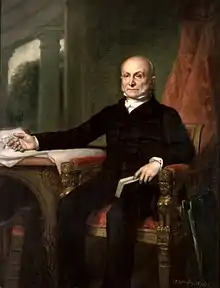
.jpg.webp)
